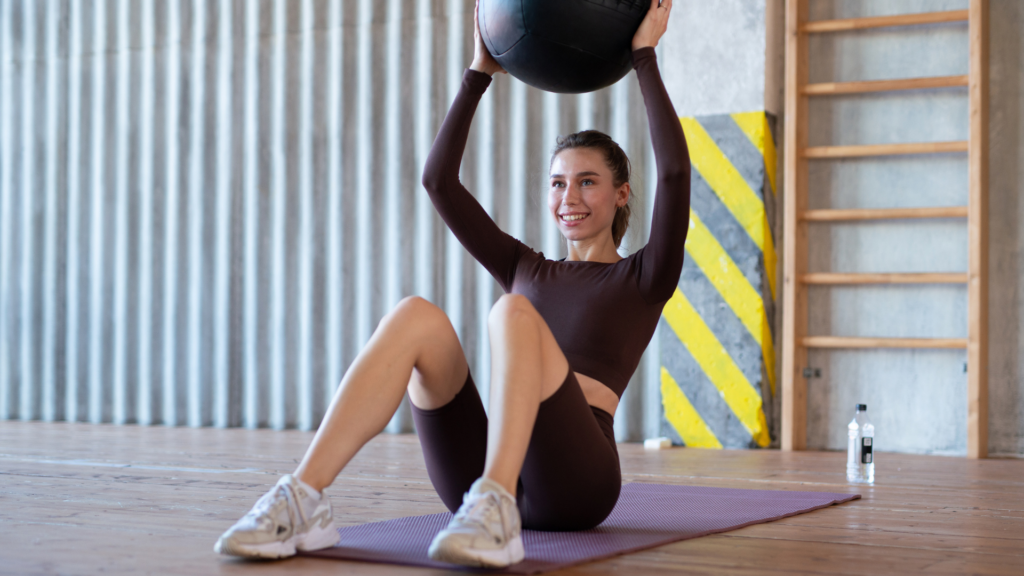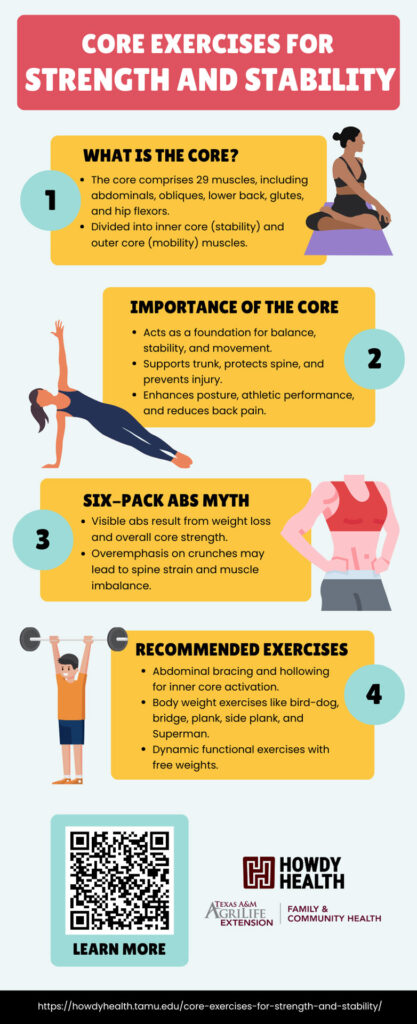What’s the Core?
The core is the foundation for our ability to produce almost all movements.1 Sometimes, the core is mistakenly considered only the stomach or abdominal muscles, but the core is actually a group of 29 muscles within the abdomen and back, and extending to the spine and through the pelvic region.
To simplify, we can think of the core muscles in 5 groups:
- Abdominals: The muscles located between your ribs and your pelvis on the front of the body.
- Obliques: The muscles on the sides of your belly.
- Lower back: All of your back muscles below your rib cage and above your glutes.
- Glutes: The muscles of your buttocks.
- Hip flexors: The muscles that connect your hips to your upper leg.2,3
The core muscles can also be divided into 2 categories:
- Inner core muscles: These muscles are located deep in the trunk attached to the spine. They join one vertebra to the next and provide stability to your pelvis. You can think of these as your “stability” muscles.
- Outer core muscles: These muscles are located closer to the body’s surface. They’re responsible for movement (as well as some stability). They work in conjunction with the inner core muscles to move the body. You can think of these as your “mobilizer’ muscles. (Six-pack/washboard abs, which we’ll talk about shortly, fall into this category.)4,5
Why is the Core Important?
Think of your core as the foundation of your house. Without a stable, strong foundation (core) your house isn’t going to stand up in a storm.4 The core muscles help you maintain balance, support your trunk, protect your spine, prevent injury, allow movement, and hold your organs in place by regulating internal abdominal pressure.3,5 Much of our movement is powered by the muscles of the core working together when we sit, stand, bend over, lift things up, exercise, and more.3,6
If your core is not strong, it can limit your balance and stability as well as impede your ability to perform daily functions and perform at your peak level of fitness.
A strong core can improve posture, balance, stability, body movement, and athletic performance. It can also reduce risk of injury, strain on the spine, and back pain.5
How to Engage the Core Muscles (Recommended Exercises)
When choosing exercises, you want to focus on building core stability and strength. To gain good core stabilization and strength, you need to identify and activate the muscles needed to accomplish the task.8
Abdominal Bracing and Hollowing
Start with Abdominal bracing and hollowing (see instructions below), to begin working your inner core stabilizer muscles before moving on to the outer stabilizers and mobilizers.1,7 Think of abdominal bracing as “co-contracting” core muscles (simultaneous activating muscles on opposite sides of a joint) and abdominal hollowing as “drawing in” core muscles (toward the spine).7
- Abdominal bracing: Stand tall with your feet hip-width apart and hands at your hips or lie down with your knees bent and your hands at your sides. Tense the muscles of your core (co-contracting) as if you were bracing to be punched in the stomach. Slowly say “Pssst,” which will help activate the core muscles. Hold the contraction for 5-10 seconds without holding your breath. Rest and repeat 2-3 times. Try to build your way up to a 20 second hold before moving onto advanced core strengthening exercises.5,7,9
- Abdominal hollowing: In a seated position draw in your belly button. Think of drawing it back toward the spine. Once the belly is drawn in, pretend you’re taking a bowel movement – this makes the inner core muscles work really hard.4 Hold the contraction for 5-10 seconds without holding your breath. Rest and repeat 2-3 times. Try to build your way up to a 20 second hold before moving onto advanced core strengthening exercises
Bodyweight Exercises
Research has shown that bodyweight exercises can increase core stability and strength.10 Many core stabilizing and strengthening exercises can be done with bodyweight, just be sure to take your time and focus on proper form. You will want to progress from gaining control of the inner stabilizer muscles to activating both inner and outer core muscles, and then adding dynamic functional exercises which mimic movements you do every day and challenge your core stability.4,7 Here are some recommended bodyweight exercises4,5,6,7,11,12,13,14,15,16,17 to get you started (use modifications when starting out and add variations for more variety and challenge):
Always check with your health care provider before beginning any new exercise program.
- Bird-dog: Kneel on your hands and knees and draw in your belly button toward your spine, keeping your abs held strong to support your back. Raise your left arm and right leg (with the foot pointing toward the floor) until they’re parallel to the floor. Hold the position for a few seconds and then return to the starting position. Repeat on the other side (right arm and left leg). Be sure you don’t twist. Work your way up to completing 2-3 sets of 10-12 repetitions on each side.6,11,17
- Bridge: Lie on your back with your knees bent and feet hip-width apart. Place your arms at your side, hands down. Tighten your glutes (buttocks) and press your feet firmly to the floor while raising your hips up off the floor, getting your shoulders, hips, and knees in a straight line. Hold for a few seconds then return to the starting position. Repeat. Work your way up to completing 2-3 sets of 10-12 repetitions.6,14
- Single-leg bridge variation: Lie in the same position as the traditional bridge (above). After raising your hips up off the ground and tightening the glutes, lift one leg at a time off the ground, hold a moment then repeat with the other leg. This will increase the challenge and intensity of the exercise by forcing one leg to stabilize your body.18
- Plank: Place your hands (or elbows/forearms [more advanced version]) on the ground aligned with your shoulders and your toes on the ground (like you’re going to do a push-up). Stay in that position keeping your muscles taut and in a straight line (like a wooden plank) from head to toe. Don’t let your stomach swoop downward or your buttocks stick upward. Hold this form for as long as you can. Start by trying to hold the position for 10 seconds. Work your way to 30 seconds, ultimately challenging yourself to hold for 1 minute or longer.6,16,17
- Modified Plank: Place your forearms on the ground aligning your shoulders directly over your elbows and your knees on the ground (keeping your feet in the air behind you). Keep your back in a straight line from head to knees and your abdominal muscles tight/contracted. Hold for as long as you can.6
- Side plank variation: Lie on your left side. Support your weight on your left elbow and leg, then raise your hips. Maintain a straight line from your head to your heels to prevent side bending. Hold the position for a few seconds and then bring your hips back down. Repeat. Switch to the right side and do the same exercise supporting your weight with your right elbow and leg. Work your way up to completing 2-3 sets of 10-12 repetitions on each side.11,14
- Superman (back extension): Lie face down with arms and legs extended. Engage (contract) your glutes (buttocks), abs, and back muscles to lift your arms and legs off the floor – just a few inches. Don’t hyperextend (trying to lift them higher). Also, don’t extend your neck upward – keep it in a straight line looking down at the ground. Hold for a few seconds then release and repeat. Work your way up to completing 2-3 sets of 10-12 repetitions.17
Dynamic Functional Exercises
Once you’ve built up some core stability and strength, try adding dynamic functional exercises with free weights (dumbbells) that move you through a range-of-motion, mimic everyday activities, and challenge your core at the same time. When you’re just starting out, practice the exercises without dumbbells to be sure you have the correct form. Add dumbbells when ready. If the exercises start feeling easy, it’s time to increase the weight of your dumbbells. Here are some recommended exercises4,13 (with links on how to perform them) to get you started:
Work your way up to completing 2-3 sets of 10-12 repetitions.
To prevent muscle strains, be sure to warm up before exercise and cool down afterwards. Focus on breathing properly (not holding your breath) and keeping good form when performing all exercises.
What About Six-Pack Abs?
No article about the core would be complete without addressing six-pack/washboard abs. If your goal is to get “six-pack” abs – hyper-cut abdominal muscles – it may be time to think differently. If you want your abdominal muscles to be more visible, it is weight loss along-side exercise that makes this possible.1
In reality, however, those hyper-cut abs may do more harm than good, especially if you’re focusing only on the outer abdominal muscles and ignoring the rest of the core musculature. In fact, if you’re focusing on crunches and sit-ups, you are only exercising a few muscles and run the risk of putting strain on your spine, especially if you make the common mistake of pulling on your neck when you crunch forward.6,14,17 Additionally, doing exercises like crunches only works your outer (surface) core muscles because you’re lying on the floor, which doesn’t create the instability to work your inner (deep) core muscles, too – the way a plank or other multi-core muscle strengthening exercise would.4
Overdeveloping your abdominal muscles at the expense of the rest of your core can also put your core out of balance. If you “aim instead for achievable core strength – you’ll stabilize your back, have more overall power, and protect yourself from injuries,”17 developing muscles that will serve you life-long – whether you can see your six-pack or not.
Want to build more healthy, life-long habits?
Step your way into the habit of healthy with one of our health or nutrition programs. View plans, resources, tips, and more for offices, schools, groups, and individuals.
Infographic
Download the PDF or share the image below to help others learn more about core exercises for strength and stability.
Core Exercises for Strength and Stability – Infographic (pdf)
- Rick Richey M. Core stability exercises: Targeting progressive core training. NASM. Accessed June 5, 2024. https://blog.nasm.org/progressive-core-training.
- Endurocad. Facebook. Accessed June 5, 2024. https://www.facebook.com/Endurocad/posts/what-is-the-corethere-are-29-core-muscles-in-total-they-are-most-easily-defined-/4387097841311762/.
- Department of Health & Human Services. Abdominal muscles. Better Health Channel. December 19, 2003. Accessed June 5, 2024. https://www.betterhealth.vic.gov.au/health/conditionsandtreatments/abdominal-muscles.
- Liebman B, Dow C. 5 exercise questions to get the most out of your workouts. Center for Science in the Public Interest. April 9, 2024. Accessed June 5, 2024. https://www.cspinet.org/article/5-exercise-questions-get-most-out-your-workouts.
- ATI Physical Therapy. ore Exercises & Training. March 14, 2023. Accessed June 5, 2024. https://www.atipt.com/blog/core-exercises-training.
- Harvard University. The best core exercises for older adults. Harvard Health. April 1, 2021. Accessed June 5, 2024. https://www.health.harvard.edu/staying-healthy/the-best-core-exercises-for-older-adults.
- Huxel Bliven KC, Anderson BE. Core stability training for injury prevention. Sports Health. 2013;5(6):514-522. doi:10.1177/1941738113481200.
- Lauren Elson M. Understanding and improving core strength. Harvard Health. September 6, 2018. Accessed June 5, 2024. https://www.health.harvard.edu/blog/understanding-and-improving-core-strength-2018090414662.
- Li G, Shourijeh MS, Ao D, Patten C, Fregly BJ. How Well Do Commonly Used Co-contraction Indices Approximate Lower Limb Joint Stiffness Trends During Gait for Individuals Post-stroke?. Front Bioeng Biotechnol. 2021;8:588908. Published 2021 Jan 7. doi:10.3389/fbioe.2020.588908.
- Barrio ED, Ramirez-Campillo R, Garcia de Alcaraz Serrano A, RaquelHernandez-García R. Effects of core training on dynamic balance stability: A systematic review and meta-analysis. Journal of sports sciences. 2022;40(16):1815-1823. Accessed May 30, 2024.
- Lee JS, Kim TH, Kim DY, Shim JH, Lim JY. Effects of selective exercise for the deep abdominal muscles and lumbar stabilization exercise on the thickness of the transversus abdominis and postural maintenance. J Phys Ther Sci. 2015;27(2):367-370. doi:10.1589/jpts.27.367.
- Martuscello, JM, Nuzzo, JL, AshleyCD, Campbell BI, Orriola JJ, Mayer, JM. Systematic Review of Core Muscle Activity During Physical Fitness Exercises. Journal of Strength and Conditioning Research 27(6):p 1684-1698, June 2013. | DOI: 10.1519/JSC.0b013e318291b8da.
- Oliva-Lozano JM, Muyor JM. Core Muscle Activity During Physical Fitness Exercises: A Systematic Review. Int J Environ Res Public Health. 2020;17(12):4306. Published 2020 Jun 16. doi:10.3390/ijerph17124306.
- Nationwide Children’s Hospital. 1. Core stability: What is it and why is it important? Accessed June 5, 2024. https://www.nationwidechildrens.org/family-resources-education/700childrens/2018/07/core-stability.
- Mayo Clinic. Exercises to improve your core strength. Mayo Clinic. August 25, 2023. Accessed June 5, 2024. https://www.mayoclinic.org/healthy-lifestyle/fitness/in-depth/core-strength/art-20546851.
- Harvard University. How to build a Better Core. Harvard Health. January 1, 2021. Accessed June 5, 2024. https://www.health.harvard.edu/staying-healthy/how-to-build-a-better-core.
- Geisinger Health. Why core strength is better than six-pack ABS. Geisinger. Accessed June 5, 2024. https://www.geisinger.org/health-and-wellness/wellness-articles/2022/07/18/19/54/core-strength-better-than-six-pack-abs.
- Hinge Health. 1. Single leg bridge: Tips and recommended variations. hingehealth. August 30, 2023. Accessed June 5, 2024. https://www.hingehealth.com/resources/articles/leg-bridge/.



